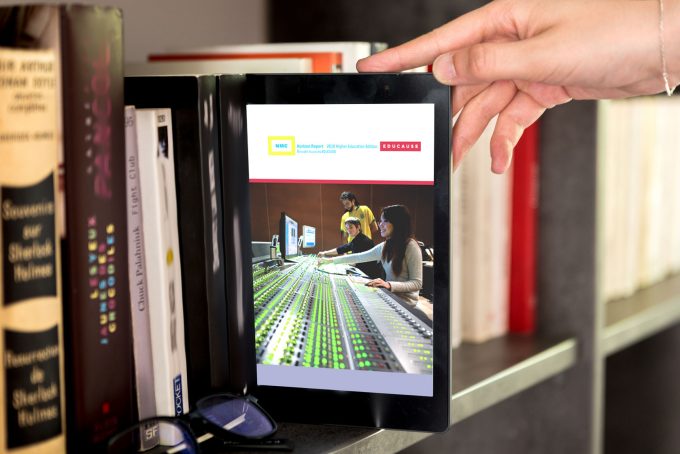
Digital Collaboration: Tips for Working Together Across Five Time Zones
Experts benefit from digital collaboration across borders, sharing their expertise. Thus, the libraries in which they work also benefit. Yvonne Tunnat talks about her experiences working across five time zones in the context of digital preservation.
by Yvonne Tunnat
Only a few people around the world work on digital preservation and even fewer deal with the topic of file formats for digital preservation. Four of my work groups are spread out across five time zones. The time and distance often make collaborating very difficult, but close communication of content-related information really advances our work.
I have been working on digital long-term archiving at the ZBW since 2011 and the world has been getting smaller and smaller. It means I am often closer to colleagues from California, Australia and New Zealand than to my other colleagues on the premises from a professional perspective. They deal with the same problems, know the answers and are there to provide help and advice.
Global work groups make organisation more complicated
I now work in four work groups with colleagues from different continents, all of whom regularly want to meet and discuss things. The distance is easy to bridge by telephone or web conferences. The time difference is more difficult. It is easy to handle within Europe as long as you avoid marginal times. For example, Great Britain is one hour behind and Estonia an hour ahead. As soon as colleagues from the east coast of the USA are involved, appointments are only possible in the late afternoon. However, two of the work groups are even further apart:
- California (9 hours behind us)
- Utah (8 hours behind us)
- Australia (8 hours ahead)
- New Zealand (10 hours ahead)
We schedule phone conferences to alternate between early mornings and late evenings. Phone conferences have also taken place at 11 pm western American time and 6 am New Zealand time.
Meetings in person strengthen bonds
Meetings in person are organised once a year. To make it fair for everyone, they are not held on the same continent each time. Although they have already been held several times in Europe, there has also been one meeting in Jerusalem and three in the USA (2x New York and 1x California). Next year’s meeting will “finally” be held in Australia. As the business trip to California was not workable for the majority of participants, the entire conference was recorded and most of it was broadcast live. I was even able to give my presentation from my computer at home – at 9 pm in the evening German time.
Hack Days – detailed work on tools and file formats
„Hack Days“ are usually held twice a year; these meetings allow us to go into real detail on file format issues and their tools. As these meetings are open to participants from around the world, Hack Days usually last 24 hours. Meetings take place online every four hours, so that everyone has the opportunity to attend at least one or two meetings during regular working hours.
We use both e-mails and the Confluence Wiki and Basecamp for our daily interaction. WebbEx is generally used for conferences.
The benefits of the international community – and the hurdles
For me, the advantage of this international collaboration is that I know the right contact person for each specific topic – and I have usually met them in person and not just spoken to them via e-mail. The intensive networking also helps us all to progress professionally and means we do not always have to reinvent the wheel. We each know what the other does, what we are working on and what has already been tried. The close exchange of expertise ensures efficiency and avoids the overlapping of work. This means we can get to know far more workflows and approaches than we would if we only worked with people in our own countries.
A disadvantage is the time difference. It is no problem for me to be at my computer by 7 am, but everything after 8 pm is exhausting. To make sure everything is fair, I do it anyway, but try to move additional tasks like logs on to my morning sessions. Travelling is also rather exhausting. Unfortunately, due to difficulties with trains or airports, I have not managed to travel to all the places I would have liked. Participating in web conferences alone is, in my opinion, not at all equivalent to being there in person and it is not easy to follow even the talk, let alone the subsequent discussion, no matter how much effort you put in.
Factors for success in digital collaboration
It takes trust that everyone in the work group is doing their part, because it is not easy to judge and certainly not easy to monitor matters when you are working over such distances. Depending on the work of others, milestone deadlines can be pushed backwards. In 2012-2015 we primarily worked via e-mail on joint position papers. This often took longer than necessary. The current system of small work groups and quarterly meetings works better and is more binding.
The key to successful collaboration across several time zones is, in my opinion that everyone needs to leave their comfort zones. We sometimes work past 8 pm. Everyone has a turn at hosting the annual conference. The Europeans sometimes travel to Australia. Everyone shares their knowledge via a webinar. This makes it uncomfortable for everyone now and then – but also makes it workable for all.
Further Information
- My first Hackathon – Hacking on PDF Files
- Truth or Dare – Validation with JHOVE (PDF in German)
- Conference Paper: A PDF Test-Set for Well-Formedness Validation in JHOVE – The Good, the Bad and the Ugly
View Comments

OSPP-REC: Towards the European Open Science Agenda
“The time to act is now.” The European Open Science Policy Platform has published a...



